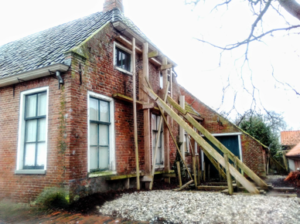
Many homes in the Netherlands, Germany, France and Belgium are heated with gas from the Netherlands. Along with a few smaller gas fields, the Groningen gas field supplies around 15 percent of Europe’s gas consumption.
In 1959 the Dutch oil and gas company NAM surprisingly discovered a huge gas field – the tenth biggest gas field in the world and the largest in Europe. Over the years, NAM produced around 1700 billion cubic meters (bcm) of gas in the Groningen fields and estimates that there are around 1000bcm left underground.
In the seventies, gas production was highest and peaked with over 80bcm of gas produced in 1976. It rose again significantly in 2013, and many people living in and around the gas fields also have an explanation why: Before 2013, the magnitude and the frequency of earthquakes rose and the damage could no longer be ignored. Given that the earthquakes are unmistakeably linked to large scale gas extraction in the region (even Shell and ExxonMobil acknowledge that), the operating gas companies knew they would soon be limited in the amount of gas they could extract and went all out to extract the then fixed maximum possible amount of gas of 53bcm – probably for the last time.
And they were right: After gas production was reduced to 53bcm in 2013, in fall 2016 production was further limited to 24bcm per year until 2021. Since earthquakes recently also started being felt in the city of Groningen with 200,000 inhabitants, the issue became more pressing.
Besides earthquakes, gas extraction also has other impacts on the region: The ground is sagging and is now already one meter lower than just a few years ago. Also, in some places ground water levels drop; in others they rise.
Earthquakes in Groningen: A disaster in slow-motion
For now, earthquakes (nearly 1000 smaller and bigger ones since the 1990s) caused by the settling of the ground after gas extraction have calmed down a bit. But there are few reasons to be optimistic about the future of damaged buildings in the area. Additionally, dams are affected and threaten to break during earthquakes. Combined with high water levels this could have devastating consequences.
Repairing all dams and affected houses would cost exorbitant amounts of money and for some buildings, such as centuries-old churches or farmhouses from the 13th or 14th century, repairs are either going to come too late or be extremely costly.
The people of the region are outraged: They live in houses with cracks getting bigger and bigger, with no way of selling their defective homes in order to move somewhere else. Due to the large scale of the problem and because NAM plays cat and mouse and denies responsibility wherever possible, many families see themselves trapped in an unsafe house with no possibility of getting out of the region. Also NAM, the cause of the quakes, is ironically the one judging the damage and defining the compensation that affected homeowners get.
A landscape shaped by gas extraction
Wherever one goes in the 90,000 square meter area affected by gas-quakes, one can see big cracks in the buildings, scaffolding and makeshift wooden props in a desperate attempt to keep walls standing, and pieces of property in the middle of villages covered by nothing but green grass. Buildings too damaged to remain standing have been demolished there in recent years.
The trained eye also notices cheap new chimneys substituting old ones that usually are the first things that fall during quakes, solar panels indicating that the family living beneath them probably got them as a compensation for their crumbling walls, and props carefully hidden beneath painted covers for distractions.
The last colony of the Netherlands
The people from Groningen call themselves the last colony of the Netherlands. Similar to the country’s former colonies, they feel exploited in an area that is the richest in the state but only benefits the gas industry. The population is comparably poor because most of the money made is pumped out of the region, leaving behind a devastating legacy: children in unsafe schools, a cultural heritage in deplorable conditions and a population with growing mental and physical health issues due to stress and hopelessness. A compensation of €1,2 billion that was promised in 2014 is not even 5 percent of the money needed to fix things in the region. It is just one more example of blatant injustice and of gas giants making lots of money on the backs of people. The Groningen example shows that the big gas companies are a long way from paying the real price of extracting fossil fuels.
Luckily, awareness is raising and the gas-quakes in Groningen are definitely going to be a big topic in the upcoming Dutch elections. As there is a future without gas, there is – and needs to be – also one without the Dutch Gas Company NAM.
Find more information and animated infographics here.


